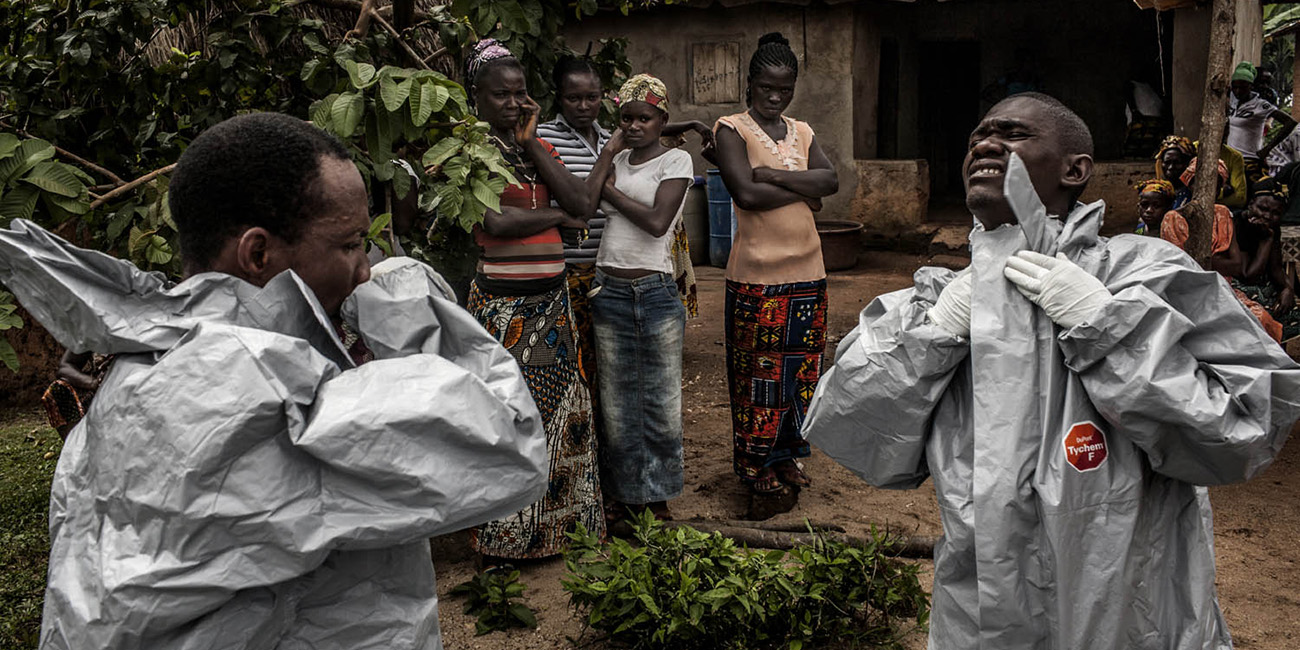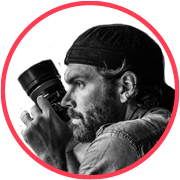
Hot Point: Photographers Shooting Ebola in Africa
American Kaci Hickox, a nurse who recently returned to the US after treating Ebola patients in Africa was banned by local authorities from appearing in public places for 21 days. Hickox’s lawyers stated that they are appealing this decision, and the UN Secretary-General condemned the treatment of physicians. Photographers covering the epidemic also face difficulties at home. A three-time Pulitzer Prize winner, Michel du Cille, passed quarantine after a trip to Africa, but Syracuse University withdrew his invitation to a workshop class. Bird In Flight spoke with photographers working in infected areas about why Ebola fever is growing, how life has changed in the countries where the virus is rampant, and what they’re eager to tell the world about it.

Why did you decide to cover Ebola?
It’s an important and evolving story that has a lot of far reaching implications, both for Africa and for the world. The story has become split. It’s like there is a story of Ebola outbreak in West Africa, and there is a story of the western panic about the prospect of Ebola reaching the west. To me, they almost seem like two different stories. When I took on the topic, I thought that it was underreported. I was one of the first wave of journalists that went in along with John Moore, Ben Solomon, Adam Nossiter, but that was it.
{ “img”: “/wp-content/uploads/2014/10/muller_01.jpg”, “alt”: “Pete Muller for The Washington Post”, “text”: “Red Cross workers prepare to enter a house where a woman is dying of Ebola in the village of Dia in Sierra Leone. Photo: Pete Muller/Prime for the Washington Post, August 18, 2014.” },
{ “img”: “/wp-content/uploads/2014/10/muller_02.jpg”, “alt”: “Pete Muller for The Washington Post”, “text”: “Red Cross workers prepare to enter a house where a woman is dying of Ebola in the village of Dia in Sierra Leone. Photo: Pete Muller/Prime for the Washington Post, August 18, 2014.” },
{ “img”: “/wp-content/uploads/2014/10/muller_03.jpg”, “alt”: “Pete Muller for The Washington Post”, “text”: “A National Health Service worker keeps track of people who have passed the 21-day quarantine at a checkpoint on the road leading from Freetown to Kenema in Sierra Leone. Photo: Pete Muller/Prime for the Washington Post, August 16, 2014” },
{ “img”: “/wp-content/uploads/2014/10/muller_04.jpg”, “alt”: “Pete Muller for The Washington Post”, “text”: “A woman washes her hands in chlorinated water at a checkpoint on the road leading from Freetown to Kenema in Sierra Leone. Photo: Pete Muller/Prime for the Washington Post, August 16, 2014.” },
{ “img”: “/wp-content/uploads/2014/10/muller_06.jpg”, “alt”: “Pete Muller for The Washington Post”, “text”: “Villagers in Sengema, Sierra Leone look through a window at a school, as Red Cross workers work with people dying from Ebola on August 18, 2014. Photo: Pete Muller/Prime for the Washington Post, August 18, 2014.” },
{ “img”: “/wp-content/uploads/2014/10/muller_07.jpg”, “alt”: “Pete Muller for The Washington Post”, “text”: “Special permission from the government is required to exit from quarantined zones. People who have been refused departure just outside a checkpoint. Photo: Pete Muller/Prime for the Washington Post, August 22, 2014.” }
How did you prepare for the trip? What kind of protection did you use?
I spent around 3 days reading everything that I could about Ebola. I didn’t really know anything about the virus — its modes of transmission, how it worked. I was reading an interview with Peter Piot, who discovered the virus in 1976 where he was explaining that you could ride on the tube in London with someone who has Ebola and not get it as long as they didn’t vomit on you. If the scientist who discovered the virus is willing to sit next to someone and feel safe, then it’s not that scary. I went to Sierra Leone. I took things I might need, like industrial chlorine tablets, rubber boots, gloves, masks, goggles and hand sanitizer, all these types of things that you just want to have on hand to enhance the protection that you have. I also took personal protective equipment, but I didn’t wear it once. I didn’t go into a house where there was a lot of Ebola, and I didn’t go inside the high risk areas of the Ebola treatment centers where very sick people are close around you.
But one of your photos is with two medical workers and an infected woman inside the room of a house?
I was relatively close, but I was still outside. I took that picture though a window.
How did all those restrictions and safety measures affect your approach?
I have done a fair amount of conflict coverage where safety is an important issue. I try not to take unnecessary risks. To make a surprising or compelling picture, you don’t need to get close to something dangerous. For example, there was a difficult case, this older man died outside of his house. The family called the Red Cross burial team, but they came after more than a day. During this time, the body was covered with a tarp over a sheet. When the medics took this all off, I could see there was a lot of hemorrhage, blood and all this stuff. So I put on my strongest lens, a 50mm, got relatively close and took a couple of pictures. I have a picture of this that is very graphic, the kind of picture that people think about when they think about Ebola. But instead of pushing any closer to take more photos, I asked myself what else was going on. When I turned around, I saw his family members. As soon as the body became visible, they were very upset. I decided to take a few photos of them reacting to the appearance of this awful sight. And I think it ended up to be a much more powerful photograph. There is always another picture you can take.
{ “img”: “/wp-content/uploads/2014/10/muller_12.jpg”, “alt”: “Pete Muller for The Washington Post”, “text”: “In the village of Dia (Sierra Leone) Red Cross workers put on protective suits before entering a house where a woman is dying from Ebola. Photo: Pete Muller/Prime for the Washington Post, August 18, 2014.” },
{ “img”: “/wp-content/uploads/2014/10/muller_13.jpg”, “alt”: “Pete Muller for The Washington Post”, “text”: “In the village of Sengema (Sierra Leone), Red Cross workers gather the body of a man who has died from Ebola. Photo: Pete Muller/Prime for the Washington Post, August 16, 2014.” },
{ “img”: “/wp-content/uploads/2014/10/muller_14.jpg”, “alt”: “Pete Muller for The Washington Post”, “text”: “Family members of the deceased. Photo: Pete Muller/Prime for the Washington Post, August 16, 2014.” },
{ “img”: “/wp-content/uploads/2014/10/muller_15.jpg”, “alt”: “Pete Muller for The Washington Post”, “text”: “Red Cross workers carry the body of a woman who has died from Ebola for burial in the village of Dia (Sierra Leone). Photo: Pete Muller/Prime for the Washington Post, August 18, 2014.” }
Is covering an epidemic comparable to covering a conflict?
I think yes. In places like Somalia, Afghanistan or Mali, you don’t really quite know where the threat is coming from exactly. A person dressed in a civilian clothes can have a bomb attached to them. So you work with a high degree of anxiety. And that to me is how Ebola felt. You aren’t quite sure who has it, you aren’t quite sure where you can get it. It can be living on a surface, you could touch something and if you touch your face or your mouth afterwards you could become infected.
Another similarity is the reaction of the government. The government has, at least in Sierra Leone and in Liberia, imposed these draconian measures where they know the virus is rampant. For example, they set up checkpoints, and prevent people from leaving the infected region. So it’s similar in a lot of ways I think.
The difference is that, in a conflict zone, you can always find a relatively safe place. Even if you go to some place where there’s a high risk to be attacked or to see a serious combat, you can retreat back from that to a place where the risk is much lower, and you can relax. With Ebola, you never really feel like you are completely safe and you can’t relax, because there’s that sense that the virus could be anywhere.
What is your opinion about how the American media has covered Ebola?
There is a very unfortunate political exploitation of the Ebola crisis. As a result, there’s a tremendous amount of misinformation and manipulation of facts. In the US there are a lot of candidates in the midterm elections that are trying to suggest that the Obama administration’s response to Ebola has been inadequate. Some of these people have an interest in making people much more afraid of Ebola. They say, “Look, the government isn’t even protecting you.” When, in fact, we do not have an Ebola outbreak in the US. I think the political exploitation is really detrimental for the real problem — Ebola in West Africa. The story has become split. It’s like there is a story of Ebola outbreak in West Africa, and there is a story of the panic in the West. That’s practically two different stories.
{ “img”: “/wp-content/uploads/2014/10/muller_05.jpg”, “alt”: “Pete Muller for The Washington Post”, “text”: “Residents of Kailahun gather next to a river. The area has a high infection rate. Photo: Pete Muller/Prime for the Washington Post, August 19, 2014.” },
{ “img”: “/wp-content/uploads/2014/10/muller_08.jpg”, “alt”: “Pete Muller for The Washington Post”, “text”: “Women mourn a family member who has died from Ebola in the village of Dia in Sierra Leone. Photo: Pete Muller/Prime for the Washington Post, August 18, 2014.” },
{ “img”: “/wp-content/uploads/2014/10/muller_09.jpg”, “alt”: “Pete Muller for The Washington Post”, “text”: “A boy runs in a rice field outside a village in Dia in Sierra Leone. Photo: Pete Muller/Prime for the Washington Post, August 18, 2014.” },
{ “img”: “/wp-content/uploads/2014/10/muller_10.jpg”, “alt”: “Pete Muller for The Washington Post”, “text”: “A soldier at a quarantine checkpoint on the road between Freetown and Kenema. Photo: Pete Muller/Prime for the Washington Post, August 22, 2014.” },
{ “img”: “/wp-content/uploads/2014/10/muller_11.jpg”, “alt”: “Pete Muller for The Washington Post”, “text”: “A soldier at a quarantine checkpoint on the road between Freetown and Kenema. Photo: Pete Muller/Prime for the Washington Post, August 22, 2014.” }
What things did you look for to uncover the story?
War reporting sometimes become too fixed on guns, fire fights, and combat, and when we cover Ebola we can get a little bit too fixed on the people in suits, body bags and the other things that have come to define people’s impressions of events like this. I thought it was really important to show that Ebola was destroying communities that exist in a very beautiful environment. Sometimes, the beauty is that the regular pace of life continues to go on regardless of circumstances. People continue to live their lives through wars, through viruses, through all kinds of extraordinary circumstances. I think it’s really important to always try to include a diverse amount of information in the report.
Like the photo of the sunset?
Yes. The Washington Post printed it huge across two pages. There was also another one with a very beautiful green landscape. These pictures were really important. They were not of things that people think of when they think of Ebola. But this is the opposite of the Ebola outbreak in Sierra Leone. And I wanted people to know what this place looks like.
Were you put in a 21 day quarantine?
I wasn’t in any formal quarantine, but they say that Ebola has 21 day incubation period. When I got out I was monitoring my temperature 4-5 times a day for at least 3 weeks just to make sure.

What was the most difficult thing?
For me personally, the most difficult thing was not being able to take pictures because it was too risky. I love my work because the camera allows you the chance to get really close to people, to go to people’s houses, to share meals with them. I couldn’t do that this time. I felt like I was losing my humanity. I was just like photo robot taking these sad pictures. That was really hard emotionally. And, from the standpoint of photography, I felt like my pictures weren’t very good.
What were you able to photograph without risking going into people’s houses?
I just did what I could. There were some photographers that went into people’s houses, but I don’t have those pictures. I decided it was too dangerous. Maybe The Wall Street Journal is angry and maybe they are okay with that. But they never told me to put myself at risk.
{ “img”: “/wp-content/uploads/2014/10/glenna_01.jpg”, “alt”: “Glenna Gordon for The Wall Street Journal”, “text”: “Medical workers struggle with the spread and effects of Ebola. Photo: Glenna Gordon for The Wall Street Journal.”},
{ “img”: “/wp-content/uploads/2014/10/glenna_02.jpg”, “alt”: “Glenna Gordon for The Wall Street Journal”, “text”: “Applications for equipment in the Department of Health of Liberia. Photo: Glenna Gordon for The Wall Street Journal.” },
{ “img”: “/wp-content/uploads/2014/10/glenna_03.jpg”, “alt”: “Glenna Gordon for The Wall Street Journal”, “text”: “Funeral workers carry the body of a local who has died from Ebola. Photo: Glenna Gordon for The Wall Street Journal.”},
{ “img”: “/wp-content/uploads/2014/10/glenna_04.jpg”, “alt”: “Glenna Gordon for The Wall Street Journal”, “text”: “Medical workers struggle with the spread and effects of Ebola. Photo: Glenna Gordon for The Wall Street Journal.”},
{ “img”: “/wp-content/uploads/2014/10/glenna_05.jpg”, “alt”: “Glenna Gordon for The Wall Street Journal”, “text”: “Medical workers struggle with the spread and effects of Ebola. Photo: Glenna Gordon for The Wall Street Journal.”}
Did you wear a protective suit?
No. Wearing the suit is actually more dangerous. You feel safe in it, you go into an infected zone, but then, when you take off your suit, you risk doing it incorrectly and catching the virus. I wore rubber boots and gloves. You need to clean the boots all the time with bleach.
You knew about risks, so why did you decide to go?
Liberia was the place where I became a photographer. I first went to Liberia in 2009, I lived there for several years. The places and people there are important to me. That’s why I wanted to go back and document this chapter in Liberian history. Ultimately, I thought was doing a Liberian story, but I was doing an Ebola story. I thought I was going back to a place I knew, but it turned out to be a completely different Liberia.
What changed?
I would meet people on the streets and hang out. I was a part of something that was around me. Now it’s the opposite. Everybody is very fearful. Among journalists, there a strange culture where we don’t always acknowledge fear. People often say, “It’s fine, no problem.” But I’m not that person. Even talking to people is dangerous. I met one woman who survived the virus. Her mother, sisters, brothers and husband died. These heartbreaking stories were everywhere.
{ “img”: “/wp-content/uploads/2014/10/glenna_06.jpg”, “alt”: “Glenna Gordon for The Wall Street Journal”, “text”: “Medical workers put on protective suits. Photo: Glenna Gordon for The Wall Street Journal.”},
{ “img”: “/wp-content/uploads/2014/10/glenna_07.jpg”, “alt”: “Glenna Gordon for The Wall Street Journal”, “text”: “Boots dry after chlorination outside the isolation center at a clinic in Monrovia (Liberia). Photo: Glenna Gordon for The Wall Street Journal.”},
{ “img”: “/wp-content/uploads/2014/10/glenna_08.jpg”, “alt”: “Glenna Gordon for The Wall Street Journal”, “text”: “Medical workers struggle with the spread and effects of Ebola. Photo: Glenna Gordon for The Wall Street Journal.”},
{ “img”: “/wp-content/uploads/2014/10/glenna_09.jpg”, “alt”: “Glenna Gordon for The Wall Street Journal”, “text”: “Medical workers struggle with the spread and effects of Ebola. Photo: Glenna Gordon for The Wall Street Journal.”},
{ “img”: “/wp-content/uploads/2014/10/glenna_10.jpg”, “alt”: “Glenna Gordon for The Wall Street Journal”, “text”: “Medical workers pray before entering an isolation center in Monrovia (Liberia). Photo: Glenna Gordon for The Wall Street Journal.”},
{ “img”: “/wp-content/uploads/2014/10/glenna_11.jpg”, “alt”: “Glenna Gordon for The Wall Street Journal”, “text”: “Monrovia, the capital of Liberia, is one of the main epicenters of the Ebola epidemic. Photo: Glenna Gordon for The Wall Street Journal.”},
{ “img”: “/wp-content/uploads/2014/10/glenna_12.jpg”, “alt”: “Glenna Gordon for The Wall Street Journal”, “text”: “Tom King Cemetery in Freetown (Sierra Leone) — a place of mass graves of victims of the outbreak. Photo: Glenna Gordon for The Wall Street Journal.”}
Is it true that one of the main issue with Ebola is not the disease itself but the absence of medical infrastructure?
Yes. But the problem isn’t just infrastructure, but I think it also has to do with the absence of basic education and knowledge of the local population. People are not familiar with the basic principles of the virus. And they don’t trust the government because they always lie. Now, when health care organizations and the government try to give them information the people don’t believe them. They continue to believe that illness is a punishment for their sins.
Syracuse University asked Michel du Cille not to teach a planned workshop class after he had been in Africa. What do you think about that and are you ready for a similar attitude?
I think they should be ashamed of themselves, and I hope that they regret this decision. He has already done his 21 days of quarantine after coming back. This kind of attitude only spreads a stigma. For me, I’m ready for a negative reaction. I visited my friend and he didn’t want to hug me. But if I don’t have any symptoms, I cannot give it to anyone. In any case, I’m checking my temperature twice a day.
New and best




